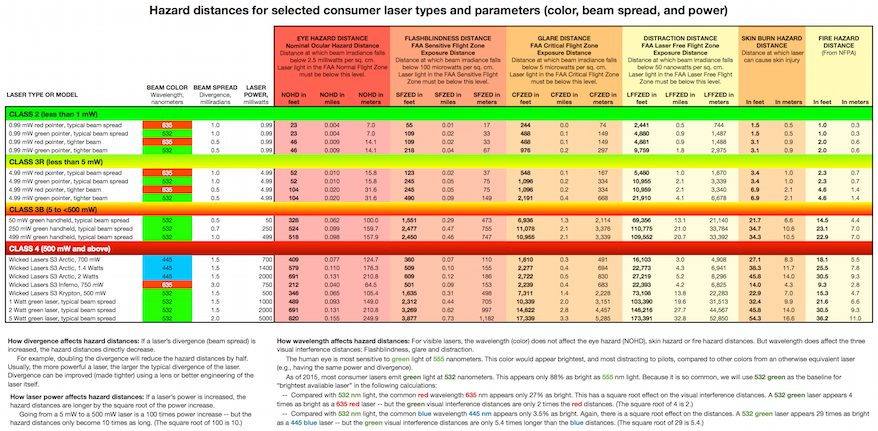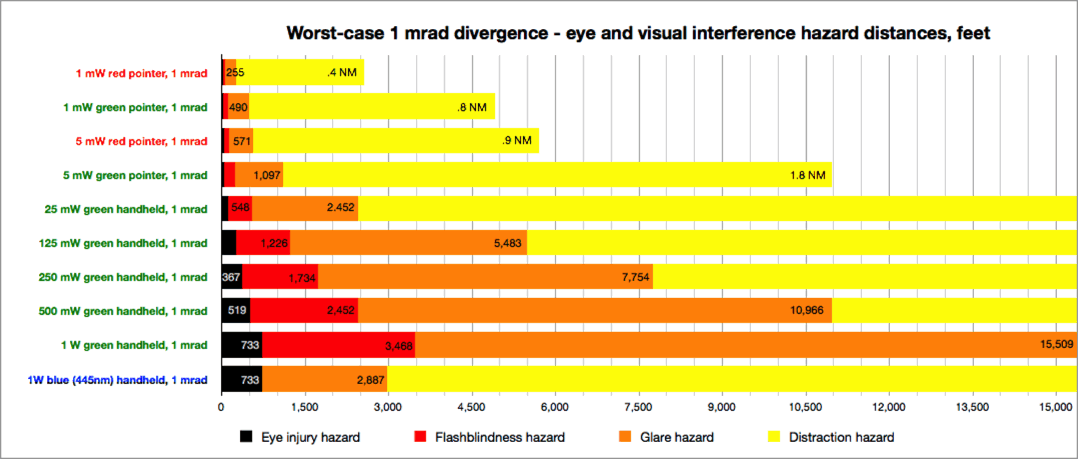Laser hazard distance chart
The chart below gives hazard distances for selected consumer laser types, and for various parameters such as the beam color, beam spread and power.
In addition, text below the chart describes how divergence (beam spread), power and wavelength (color) affects these hazard distances. The text has also been reproduced on this page, for ease of reading.
For additional details, see the web pages Laser safety calculations for eye and visual interference hazard distances and Basic principles of laser beam hazards for aviation.
Click chart for larger view

Click chart for larger view
How divergence affects hazard distances
If a laser’s divergence (beam spread) is increased, the hazard distances directly decrease. For example, doubling the divergence will reduce the hazard distances by half:


Color indicates the relative hazard: Red = potential injury, green = unlikely injury. Beyond the Nominal Ocular Hazard Distance, the chance of injury is “vanishingly small” according to safety experts.
The diagrams above depict the NOHD being reduced by half, but this reduction also applies to skin and fire hazard distances, and to the visual interference distances (flashblindness, glare and distraction). Doubling a laser’s divergence will reduce all of these hazard distances by half.
Usually, the more powerful a laser, the larger the typical divergence of the laser. Divergence can be improved (made tighter) using a lens or better engineering of the laser itself.
How laser power affects hazard distances
If a laser’s power is increased, the hazard distances are longer by the square root of the power increase. Going from a 5 mW to a 500 mW laser is a 100 times power increase -- but the hazard distances only become 10 times as long. (The square root of 100 is 10.)


However, note that in general, the higher the laser power, the higher the divergence. Because the beam is spreading out faster, the power density (irradiance) drops. This helps make the beam safer and thus the NOHD shorter, compared to a situation where the divergence doesn’t increase as laser power increases.
Both of these effects are a bit of good news for pilots and others concerned about increasing laser powers. As consumers obtain more powerful lasers, the hazard distances (NOHD, visual interference) increase less than one might expect. A laser 100 times as powerful is not 100 times as dangerous; it is “only” 10 times as dangerous, assuming the divergence is the same. And since divergence usually increases with power, the beam may be even less hazardous due to the increased spreading.
How wavelength affects hazard distances
For visible lasers, the wavelength (color) does not affect the eye hazard (NOHD), skin hazard or fire hazard distances. But wavelength does affect the three visual interference distances: Flashblindness, glare and distraction.
The human eye is most sensitive to green light of 555 nanometers. This color would appear brightest, and most distracting to pilots, compared to other colors from an otherwise equivalent laser (e.g., having the same power and divergence).
Most consumer lasers emit green light at 532 nanometers. This appears to the eye only 88% as bright as 555 nm light. Because it is so common, we will use 532 green as the baseline for “brightest available laser” in the following calculations:
- Compared with 532 nm light, the common red wavelength 635 nm appears only 27% as bright. This has a square root effect on the visual interference distances. A 532 green laser appears 4 times as bright as a 635 red laser -- but the green visual interference distances are only 2 times the red distances. (The square root of 4 is 2.)
- Compared with 532 nm light, the common blue wavelength 445 nm appears only 3.5% as bright. Again, there is a square root effect on the distances. A 532 green laser appears 29 times as bright as a 445 blue laser -- but the green visual interference distances are only 5.4 times longer than the blue distances. (The square root of 29 is 5.4.)



Some example lasers
The diagram below shows how power and color affect hazard distances. For comparison purposes, all lasers have a 1 milliradian divergence, although in the real world, the divergence generally increases as the power increases. Here are a few interesting things to notice:
- Comparing the top two bars, we see how color affects a visual interference distance. The 1 mW red pointer has a glare distance of 255 feet, compared to the same power green laser, which can cause glare at 490 feet.
- Similarly, the bottom two bars show that the green laser has much longer visual interference distances than the blue laser -- even though they both are the same power and thus have the same NOHD distance.
- Comparing the 5 mW green pointer to the 500 mW green pointer, we see how power affects hazard distances. The 500 mW laser is 100 times more powerful, but the glare distance is only 10 times greater. Although the numbers are not shown on this chart, the same effect happens to the NOHD. The 500 mW laser’s NOHD is only 10 times the NOHD of the 5 mW laser, despite being 100 times more powerful.
Click diagram for larger view

Click diagram for larger view
Go to the top
